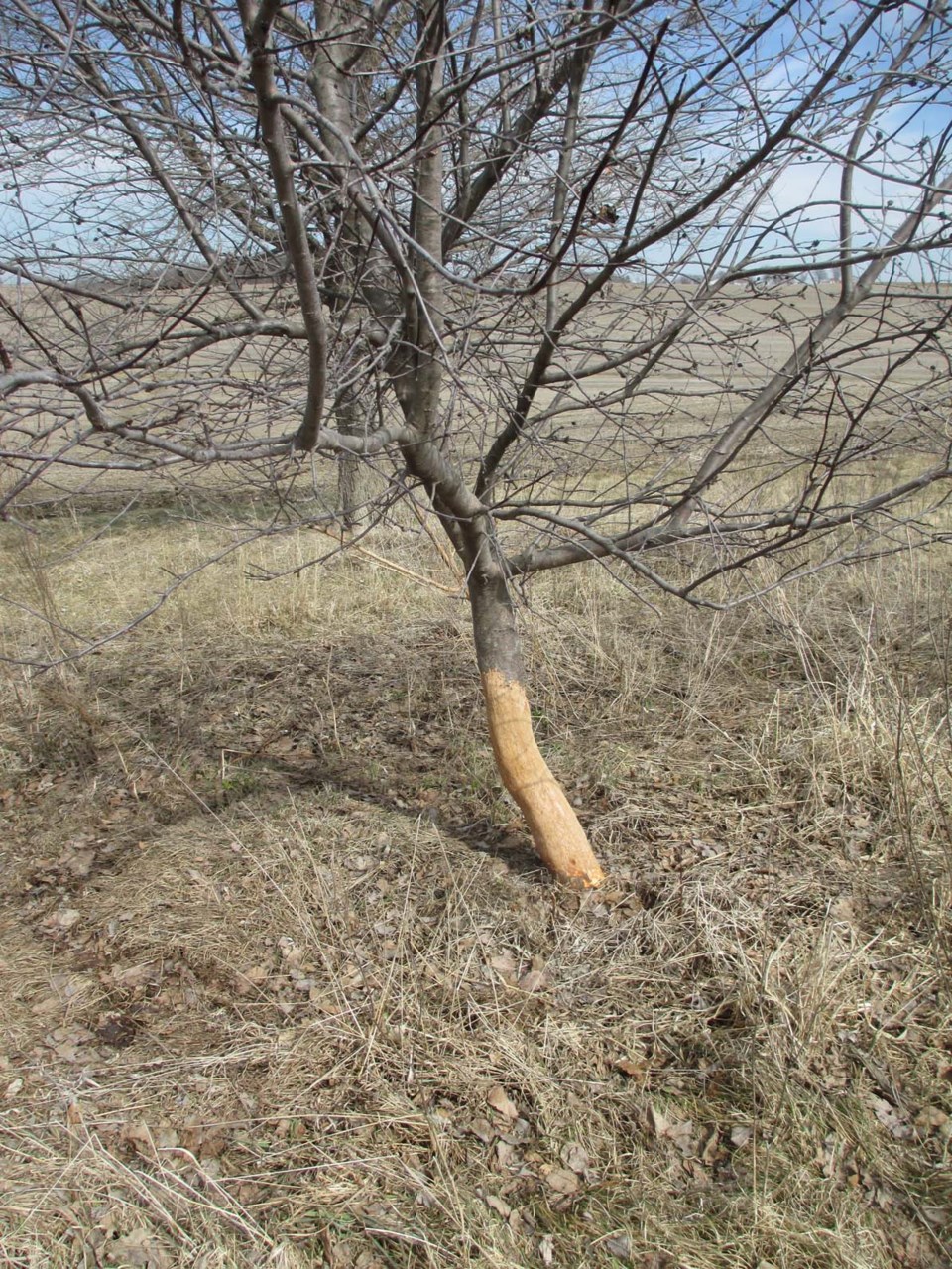White winter rabbits are the cutest – at a distance and in someone else’s yard. Mice, on the other hand, are rarely considered cute except perhaps by their mothers. During winter, both can cause a little to a lot of damage to your yard and garden, especially to the trees and shrubs. Of course, you don’t notice the damage until the snow is gone and your woody plants are starting to leaf out.
Stems and bark are good sources of nutrition for animals in the winter, especially when compared to dried grasses and other desiccated herbaceous plants. Rabbits cause damage by eating the bark down to the wood. When they eat completely around a trunk or branch, they effectively girdle it, cutting off the flow of nutrients and water between the root and the living portion above the damaged area. In spring, woody plants may initially flower or leaf out, but eventually, the portion above the girdled area dies. Rabbits will also consume small branches and twigs. Mice cause similar damage but are less likely to kill a tree unless their numbers are completely out of control.
Trees with light to moderate damage can recover. However, even if not completely girdled, expect some branches above the visible damage to be less vigorous or even die. Shrubs can take more damage as they can sprout new branches from the surviving stumps or from below ground (i.e. suckers). Prune out any deadwood. While bridge grafting may save a tree with a girdled trunk, it is a difficult technique with limited success. Severely damaged trees are best removed and replaced.
Prevention
Preventing access to the tasty, nutritious tree bark is the easiest approach. Trees and shrubs can be protected from rabbits by fencing around the tree (5-10 cm / 2-5 inches away from the trunk) using chicken wire or galvanized wire mesh (10-20 mm / 0.5-1” squares). Preventing mouse damage will require a finer wire mesh (5 mm / 0.25”). Dig the fence into the ground about 7.5-10 cm (3-4 inches) to prevent rabbits and mice from crawling under, and it should reach at least 50 cm (2 feet) above the expected snow line. After a heavy snowfall, remove snow as required to maintain enough fence above the snowline to prevent rabbits from reaching over.
Commercial tree protectors are also available from most garden centres (e.g. spiral tree wrap, corrugated tubing, plastic mesh) for protecting smaller-diameter, single-trunked trees.
Discouragement
Repellents, available from garden centres, work by either making the bark less tasty (e.g. very bitter or spicy hot such as capsaicin) or by fooling bark-munching animals into thinking there’s a predator nearby (e.g., wolf or other equally disgusting urine). The repellents can be painted or sprayed onto tree trunks and shrubs. Some products are longer lasting than others – read and follow product labels.
Habitat change
Loose organic mulch (dry leaves, straw, wood/bark chips), while very effective in reducing weeds, protecting roots against extreme temperatures and conserving soil moisture, can be an excellent overwintering habitat for mice. Before freeze-up, push mulch about 15 cm (6 inches) away from tree trunks and shrubs. In my garden, I have found mice like to nest in the middle of my Karl Foerster grass clumps. So this year, I cut them back this fall rather than waiting until spring.
Population control
Use rodenticides as a last resort when mice populations are high and they threaten not only your landscape but are also an occasional indoor visitor. Put out bait stations in late fall before freeze-up. Place them close to suspected mouse habitat but where other animals, pets and small children won’t have access to them. Inspect the bait stations regularly and refill them as necessary. Follow label instructions.
Susceptible species
Most often, young trees and thin-barked trees are the most susceptible to severe rodent damage. But when food sources are scarce and populations are high, all trees and shrubs are potentially at risk. The following are species that are especially tasty and would benefit from protection.
• Trees: fruit (apple, crabapple, pear); ornamental (hawthorn, linden, mountain ash, poplar, willow);
• Shrubs: fruit (raspberry, saskatoon, sour cherry); flowering (barberry, burning bush/winged euonymus, forsythia, lilac, rose, spirea, willow), small evergreens.
On the other hand, the following are rarely reported to be damaged: black walnut, Colorado spruce, cotoneaster, dogwood, Ohio buckeye, and potentilla.
Erl gardens in Saskatoon and enjoys being a climate zone denier by trying new and interesting perennials.
This column is provided courtesy of the Saskatchewan Perennial Society (SPS; [email protected] ). Check our website (www.saskperennial.ca) or Facebook page (www.facebook.com/saskperennial) for a list of upcoming gardening events.
SASKTODAY.ca is Saskatchewan's home page. Bookmark us at this link.




